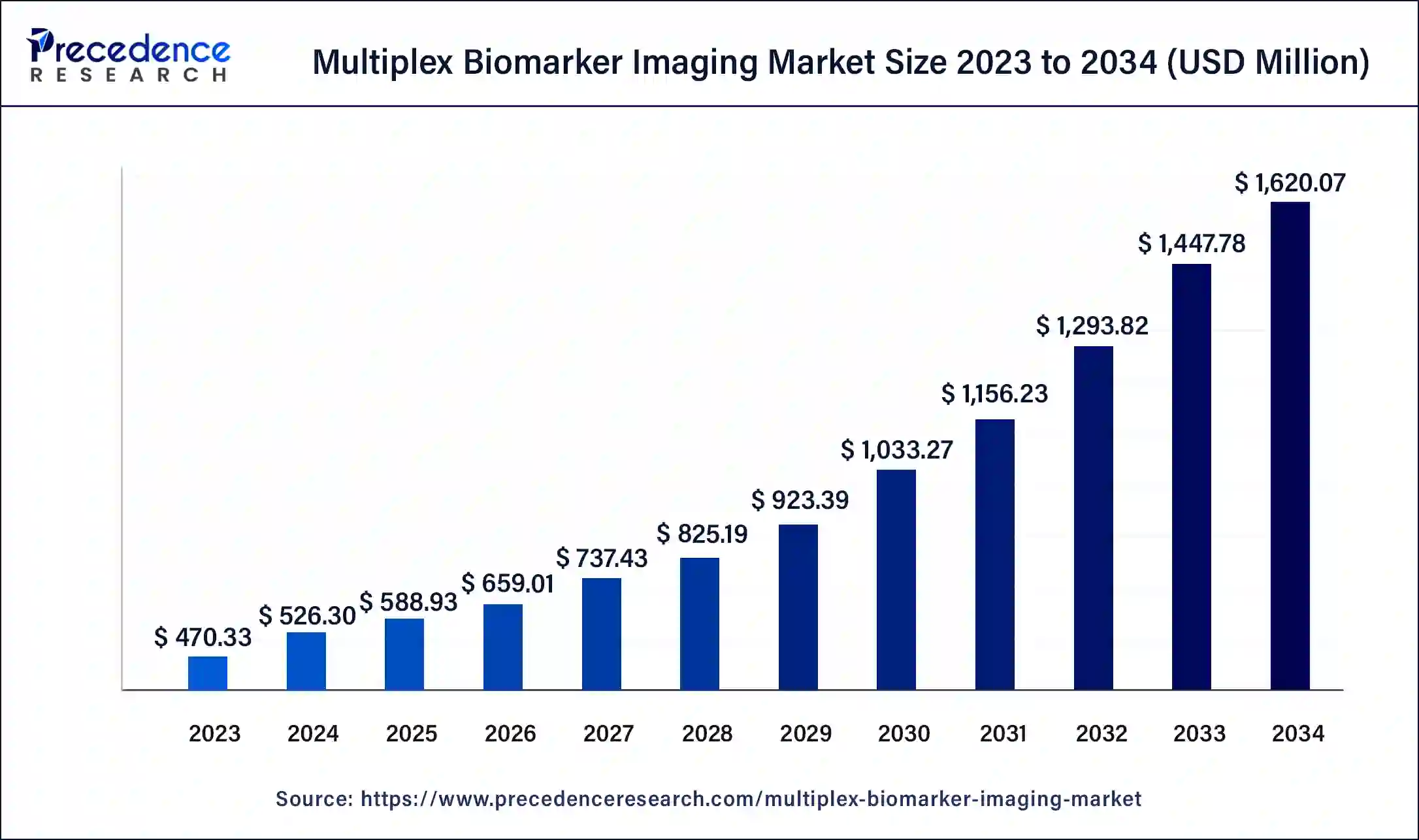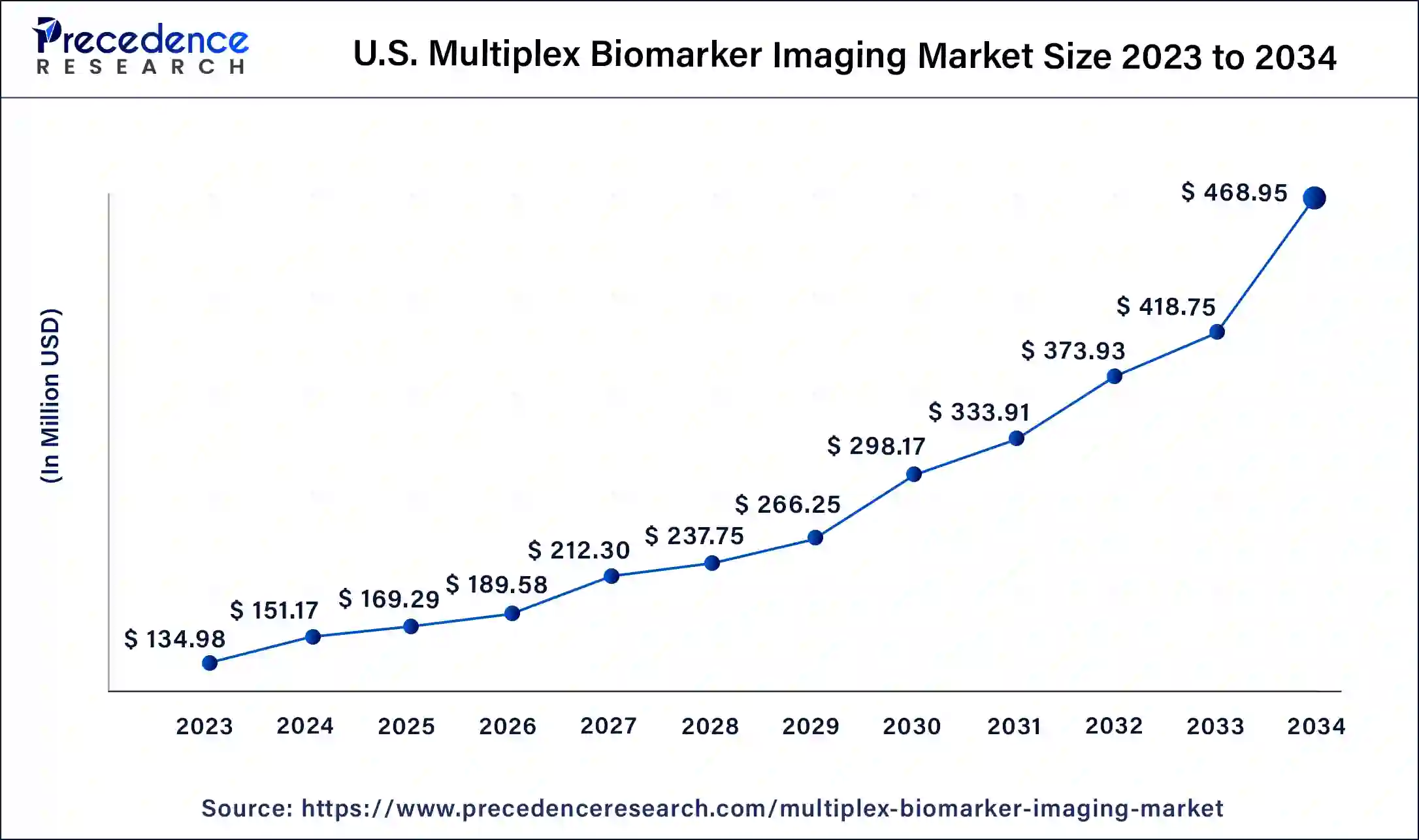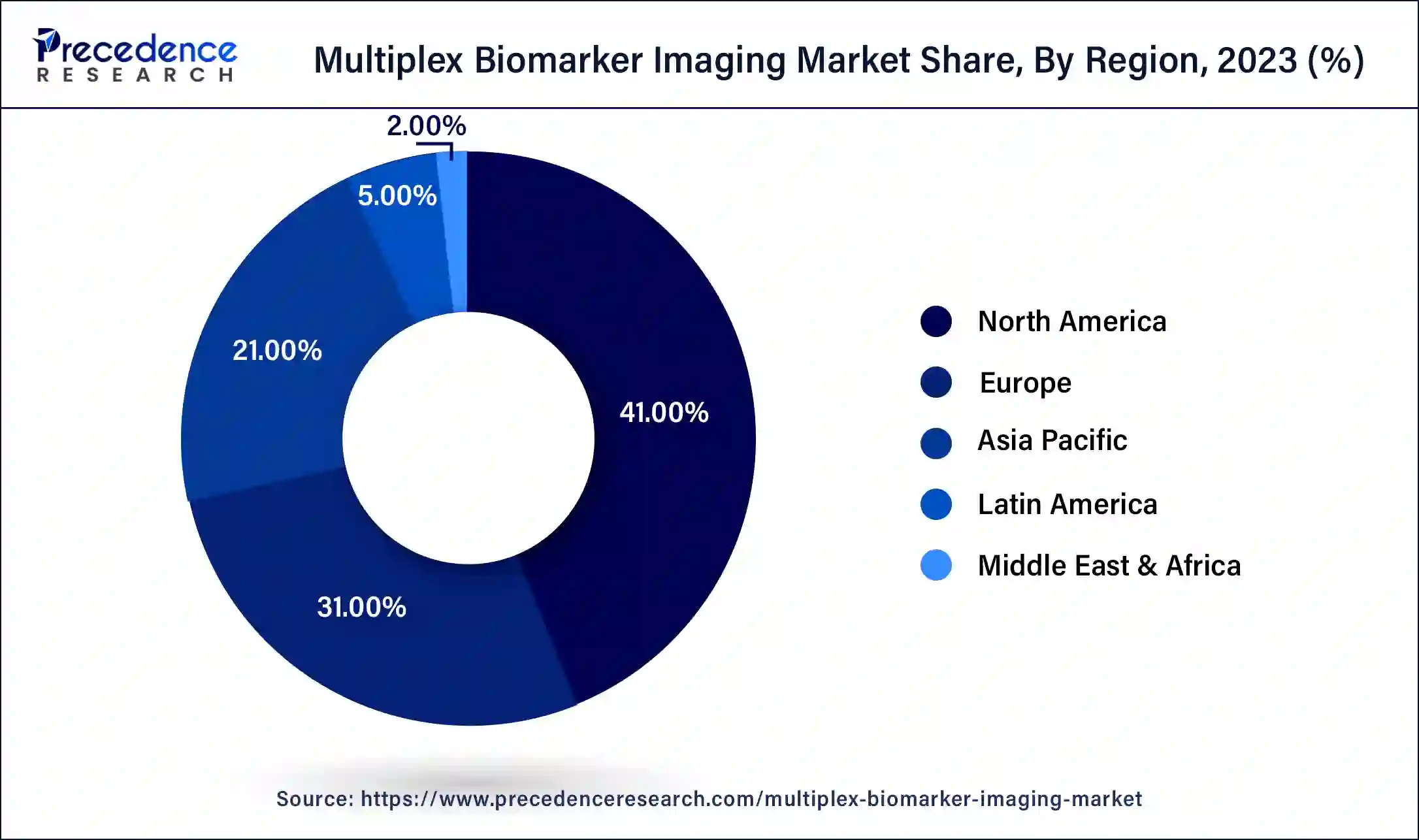February 2025
The global multiplex biomarker imaging market size was USD 470.33 million in 2023, estimated at USD 526.30 million in 2024 and is expected to be worth around USD 1620.07 million by 2034, expanding at a CAGR of 11.90% from 2024 to 2034.
The global multiplex biomarker imaging market size accounted for USD 526.30 million in 2024 and is anticipated to reach around USD 1620.07 million by 2034, expanding at a soild CAGR of 11.90% from 2024 to 2034. The North America multiplex biomarker imaging market size reached USD 192.94 million in 2023.

The U.S. multiplex biomarker imaging market size was valued at USD 134.98 million in 2023 and is expected to surpass aroud USD 468.95million by 2034, at a CAGR of 11.99% from 2024 to 2034.

North America has held the largest revenue share 41% in 2023. North America holds a significant share in the multiplex biomarker omaging market due to robust research and development activities, a well-established healthcare infrastructure, and a high adoption rate of advanced diagnostic technologies. The presence of key market players, strategic collaborations between research institutions and industry, and substantial investments in biomedical research contribute to the region's dominance. Additionally, a favorable regulatory environment and the increasing prevalence of chronic diseases drive the demand for Multiplex Biomarker Imaging technologies, consolidating North America's prominent position in this market.

Asia-Pacific is estimated to observe the fastest expansion. Asia-Pacific dominates the multiplex biomarker imaging market due to escalating research in life sciences and biotechnology. The region's increasing focus on precision medicine and the prevalence of chronic diseases fuel the demand for advanced diagnostic tools. Government initiatives, technological advancements, and collaborations between research institutions and industry players contribute to the widespread adoption of multiplex biomarker imaging technologies. As a result, Asia-Pacific stands as a pivotal player, holding substantial growth in the overall market.
Multiplex biomarker imaging stands at the forefront of medical diagnostics and research, revolutionizing the way we examine tissue samples. Unlike traditional methods that focus on a limited number of markers, this advanced technique allows simultaneous visualization and analysis of numerous biological indicators within a single sample. By leveraging sophisticated imaging platforms like fluorescence microscopy or mass spectrometry, multiplex biomarker Imaging provides a comprehensive understanding of cellular and molecular interactions.
The significance of this technology lies in its capacity to unravel intricate biological processes and disease mechanisms, offering profound insights into the correlations among diverse biomarkers. It proves pivotal in comprehending diseases at the molecular level, steering the development of precise treatments and personalized medicine. With broad applications in pathology, oncology, and drug development, multiplex biomarker imaging emerges as an indispensable tool for researchers and healthcare professionals seeking nuanced perspectives on the intricacies of various diseases.
| Report Coverage | Details |
| Growth Rate from 2024 to 2034 | CAGR of 11.90% |
| Market Size in 2023 | USD 470.33 Million |
| Market Size in 2024 | USD 526.30 Million |
| Market Size by 2034 | USD 1,620.07 Million |
| Largest Market | North America |
| Base Year | 2023 |
| Forecast Period | 2024 to 2034 |
| Segments Covered | Component Type, Imaging Technique, and Region |
| Regions Covered | North America, Europe, Asia-Pacific, Latin America, and Middle East & Africa |
Increased focus on personalized medicine and rising incidence of chronic diseases
The growing interest in personalized medicine and the increasing occurrence of chronic diseases are driving a surge in demand for multiplex biomarker imaging. In the realm of personalized medicine, there is a rising need for advanced diagnostic tools capable of comprehensively assessing individual patient characteristics. multiplex biomarker imaging meets this demand by allowing the simultaneous examination of multiple biomarkers within a single sample.
This unique capability is crucial for identifying distinct molecular patterns associated with specific diseases, enabling tailored treatment approaches that optimize effectiveness while minimizing potential side effects. Furthermore, the upswing in chronic diseases like cancer, diabetes, and cardiovascular disorders has created a pressing necessity for more advanced diagnostic solutions.
Multiplex biomarker imaging emerges as a key player in early disease detection, prognosis, and treatment monitoring, providing a comprehensive understanding of intricate biomolecular interactions. As the prevalence of chronic conditions continues to escalate globally, the adaptable and precise nature of multiplex biomarker imaging positions it as an invaluable asset in modern healthcare, driving substantial growth in the market.
Limited standardization
Limited standardization poses a significant restraint on the growth of the multiplex biomarker imaging market. The absence of universally accepted protocols and standardized procedures in sample preparation, imaging techniques, and data analysis introduces variability across different studies and laboratories. This lack of consistency hampers the reliability and comparability of multiplex biomarker imaging results, hindering its widespread adoption. Researchers and healthcare professionals face challenges in reproducibility and cross-study validation, limiting confidence in the technology's outcomes. Standardization issues also complicate data interpretation, potentially leading to discrepancies in the identification and validation of biomarkers.
Addressing this restraint requires concerted efforts within the scientific community to establish standardized guidelines, ensuring the reliability and reproducibility of multiplex biomarker imaging results and facilitating its seamless integration into clinical practice and research endeavors.
Expanded applications in drug development
The multiplex biomarker imaging market is experiencing promising opportunities with its expanded applications in drug development. This technology stands out by simultaneously analyzing multiple biomarkers within a single sample, significantly aiding various stages of drug discovery. Its role in understanding intricate molecular interactions in disease processes enhances the identification and validation of potential drug targets, contributing to more precise preclinical studies.
Moreover, multiplex biomarker imaging plays a crucial role in monitoring biomarker responses during clinical trials, offering valuable insights into treatment effectiveness. As the pharmaceutical industry increasingly embraces targeted therapies, this technology proves instrumental in streamlining drug development processes, improving success rates, and advancing precision medicine. Its unique capabilities position multiplex biomarker imaging as a key player in shaping the future of personalized and effective treatments.
In 2023, the instruments segment had the highest market share of 42% based on the type. In the context of multiplex biomarker imaging, the instruments segment encompasses the specialized equipment used for biomarker analysis, including advanced imaging platforms like fluorescence microscopes and mass spectrometers. These instruments are designed to enable the simultaneous detection and visualization of multiple biomarkers within a single sample, providing valuable insights for research and diagnostics.
Current trends in the instruments segment of the multiplex biomarker imaging market involve continuous technological advancements to enhance imaging resolution, increase multiplexing capabilities, and improve user-friendly interfaces. Additionally, there is a growing focus on developing compact and portable instruments, expanding the accessibility of multiplex biomarker Imaging technologies across various healthcare and research settings.
The software segment is anticipated to expand at a significant CAGR of 5.2% during the projected period. The software segment in the multiplex biomarker imaging market encompasses specialized programs designed for data analysis, image processing, and interpretation of complex biomolecular information obtained through imaging systems.
These software solutions facilitate the efficient extraction of meaningful insights from multiplexed biomarker data, enhancing the technology's diagnostic and research capabilities. Current trends in this segment include the integration of advanced algorithms for more accurate data interpretation, user-friendly interfaces to streamline workflows, and a focus on ensuring interoperability with other diagnostic technologies for seamless integration into existing healthcare systems.
According to the imaging technique, the immunohistochemistry (IHC) assay has held a 44% revenue share in 2023. In the multiplex biomarker imaging market, the Immunohistochemistry (IHC) assay segment involves a technique that visualizes biomarkers within tissue samples. IHC allows simultaneous detection of multiple proteins, enabling a comprehensive understanding of cellular activities.
A prominent trend in this segment includes the increasing adoption of multiplex IHC assays, allowing the visualization of multiple biomarkers within a single tissue sample. This trend enhances the efficiency of biomarker analysis, providing researchers and clinicians with a more detailed and holistic view of cellular interactions for improved diagnostic and research applications.
The tissue microarray (TMA) assay segment is anticipated to expand fastest over the projected period. The tissue microarray (TMA) assay segment in the multiplex biomarker imaging market involves a technique where multiple tissue samples are arranged on a single microscopic slide, allowing simultaneous analysis of numerous biomarkers. This high-throughput method streamlines research, enabling efficient examination of multiple specimens in a single experiment. A growing trend in the multiplex biomarker imaging market involves the increasing adoption of TMA assays for comprehensive profiling of biomarkers, enhancing researchers' ability to explore diverse molecular signatures and accelerating advancements in pathology and drug discovery.
Segments Covered in the Report
By Component Type
By Imaging Technique
By Geography
For inquiries regarding discounts, bulk purchases, or customization requests, please contact us at sales@precedenceresearch.com
No cookie-cutter, only authentic analysis – take the 1st step to become a Precedence Research client
February 2025
January 2025
September 2024
January 2025